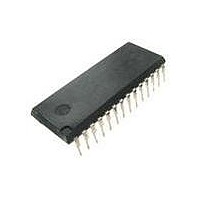MC9S08RD32PE Freescale Semiconductor, MC9S08RD32PE Datasheet - Page 90

MC9S08RD32PE
Manufacturer Part Number
MC9S08RD32PE
Description
IC MCU 32K FLASH 2K RAM 28-DIP
Manufacturer
Freescale Semiconductor
Series
HCS08r
Datasheet
1.MC9S08RE8FJE.pdf
(234 pages)
Specifications of MC9S08RD32PE
Core Processor
HCS08
Core Size
8-Bit
Speed
8MHz
Connectivity
SCI
Peripherals
LVD, POR, PWM, WDT
Number Of I /o
23
Program Memory Size
32KB (32K x 8)
Program Memory Type
FLASH
Ram Size
2K x 8
Voltage - Supply (vcc/vdd)
1.8 V ~ 3.6 V
Oscillator Type
Internal
Operating Temperature
0°C ~ 70°C
Package / Case
28-DIP (0.600", 15.24mm)
Processor Series
S08RD
Core
HCS08
Data Bus Width
8 bit
Data Ram Size
2 KB
Interface Type
SCI
Maximum Clock Frequency
8 MHz
Number Of Programmable I/os
39
Number Of Timers
2
Operating Supply Voltage
1.8 V to 3.6 V
Maximum Operating Temperature
+ 70 C
Mounting Style
Through Hole
3rd Party Development Tools
EWS08
Development Tools By Supplier
DEMO9S08RG60E
Minimum Operating Temperature
0 C
Lead Free Status / RoHS Status
Lead free / RoHS Compliant
Eeprom Size
-
Data Converters
-
Lead Free Status / Rohs Status
Lead free / RoHS Compliant
Available stocks
Company
Part Number
Manufacturer
Quantity
Price
Company:
Part Number:
MC9S08RD32PE
Manufacturer:
Freescale Semiconductor
Quantity:
135
- Current page: 90 of 234
- Download datasheet (2Mb)
Central Processor Unit (S08CPUV2)Central Processor Unit (S08CPUV2)
7.3
Addressing modes define the way the CPU accesses operands and data. In the HCS08, all memory, status
and control registers, and input/output (I/O) ports share a single 64-Kbyte linear address space so a 16-bit
binary address can uniquely identify any memory location. This arrangement means that the same
instructions that access variables in RAM can also be used to access I/O and control registers or nonvolatile
program space.
Some instructions use more than one addressing mode. For instance, move instructions use one addressing
mode to specify the source operand and a second addressing mode to specify the destination address.
Instructions such as BRCLR, BRSET, CBEQ, and DBNZ use one addressing mode to specify the location
90
Field
V
H
N
Z
C
7
4
3
2
1
0
I
Addressing Modes
Two’s Complement Overflow Flag — The CPU sets the overflow flag when a two’s complement overflow occurs.
The signed branch instructions BGT, BGE, BLE, and BLT use the overflow flag.
0 No overflow
1 Overflow
Half-Carry Flag — The CPU sets the half-carry flag when a carry occurs between accumulator bits 3 and 4 during
an add-without-carry (ADD) or add-with-carry (ADC) operation. The half-carry flag is required for binary-coded
decimal (BCD) arithmetic operations. The DAA instruction uses the states of the H and C condition code bits to
automatically add a correction value to the result from a previous ADD or ADC on BCD operands to correct the
result to a valid BCD value.
0 No carry between bits 3 and 4
1 Carry between bits 3 and 4
Interrupt Mask Bit — When the interrupt mask is set, all maskable CPU interrupts are disabled. CPU interrupts
are enabled when the interrupt mask is cleared. When a CPU interrupt occurs, the interrupt mask is set
automatically after the CPU registers are saved on the stack, but before the first instruction of the interrupt service
routine is executed.
Interrupts are not recognized at the instruction boundary after any instruction that clears I (CLI or TAP). This
ensures that the next instruction after a CLI or TAP will always be executed without the possibility of an intervening
interrupt, provided I was set.
0 Interrupts enabled
1 Interrupts disabled
Negative Flag — The CPU sets the negative flag when an arithmetic operation, logic operation, or data
manipulation produces a negative result, setting bit 7 of the result. Simply loading or storing an 8-bit or 16-bit value
causes N to be set if the most significant bit of the loaded or stored value was 1.
0 Non-negative result
1 Negative result
Zero Flag — The CPU sets the zero flag when an arithmetic operation, logic operation, or data manipulation
produces a result of 0x00 or 0x0000. Simply loading or storing an 8-bit or 16-bit value causes Z to be set if the
loaded or stored value was all 0s.
0 Non-zero result
1 Zero result
Carry/Borrow Flag — The CPU sets the carry/borrow flag when an addition operation produces a carry out of bit
7 of the accumulator or when a subtraction operation requires a borrow. Some instructions — such as bit test and
branch, shift, and rotate — also clear or set the carry/borrow flag.
0 No carry out of bit 7
1 Carry out of bit 7
Table 7-1. CCR Register Field Descriptions
MC9S08RC/RD/RE/RG Data Sheet, Rev. 1.11
Description
Freescale Semiconductor
Related parts for MC9S08RD32PE
Image
Part Number
Description
Manufacturer
Datasheet
Request
R
Part Number:
Description:
Manufacturer:
Freescale Semiconductor, Inc
Datasheet:
Part Number:
Description:
Manufacturer:
Freescale Semiconductor, Inc
Datasheet:
Part Number:
Description:
Manufacturer:
Freescale Semiconductor, Inc
Datasheet:
Part Number:
Description:
Manufacturer:
Freescale Semiconductor, Inc
Datasheet:
Part Number:
Description:
Manufacturer:
Freescale Semiconductor, Inc
Datasheet:
Part Number:
Description:
Manufacturer:
Freescale Semiconductor, Inc
Datasheet:
Part Number:
Description:
Manufacturer:
Freescale Semiconductor, Inc
Datasheet:
Part Number:
Description:
Manufacturer:
Freescale Semiconductor, Inc
Datasheet:
Part Number:
Description:
Manufacturer:
Freescale Semiconductor, Inc
Datasheet:
Part Number:
Description:
Manufacturer:
Freescale Semiconductor, Inc
Datasheet:
Part Number:
Description:
Manufacturer:
Freescale Semiconductor, Inc
Datasheet:
Part Number:
Description:
Manufacturer:
Freescale Semiconductor, Inc
Datasheet:
Part Number:
Description:
Manufacturer:
Freescale Semiconductor, Inc
Datasheet:
Part Number:
Description:
Manufacturer:
Freescale Semiconductor, Inc
Datasheet:
Part Number:
Description:
Manufacturer:
Freescale Semiconductor, Inc
Datasheet:











